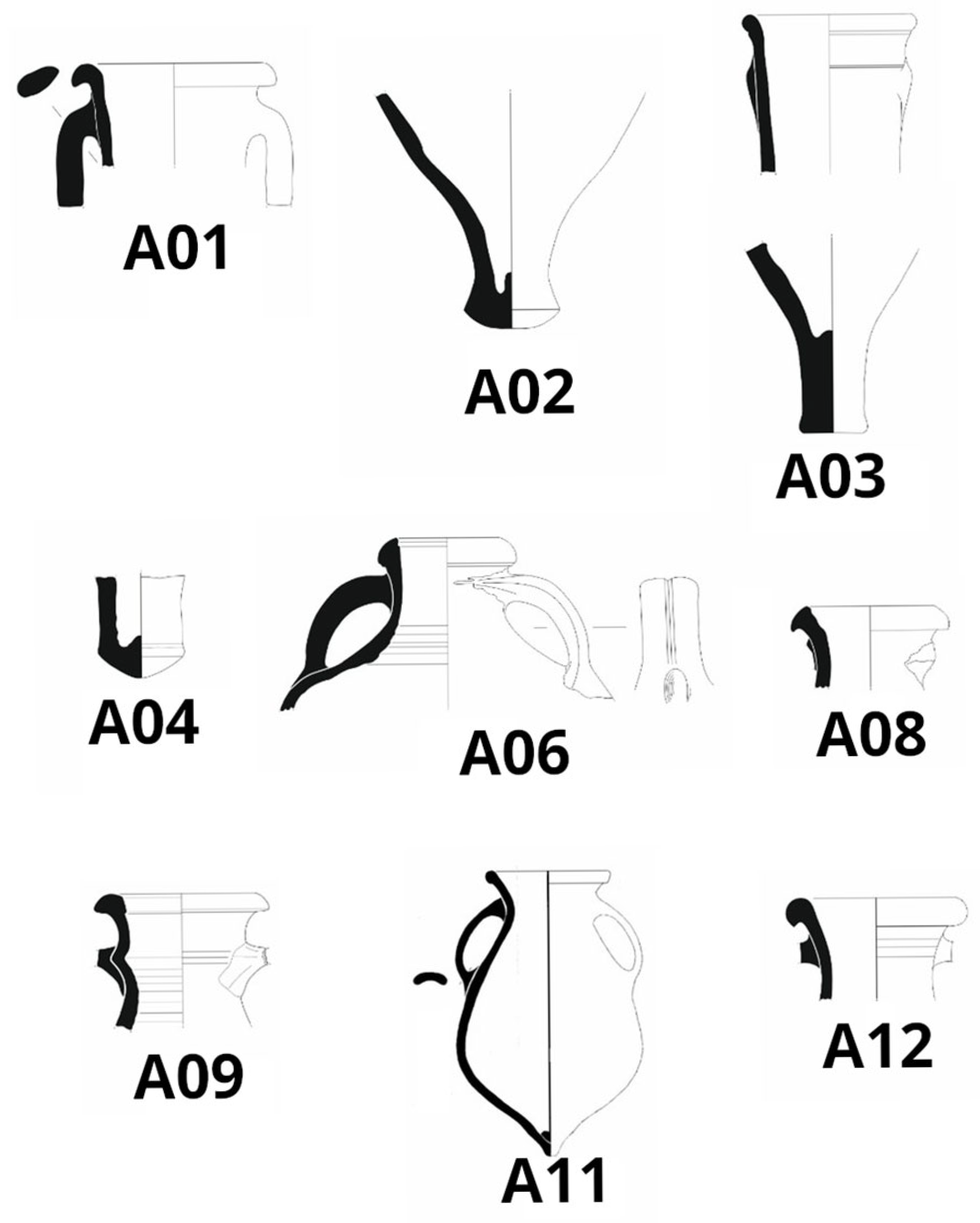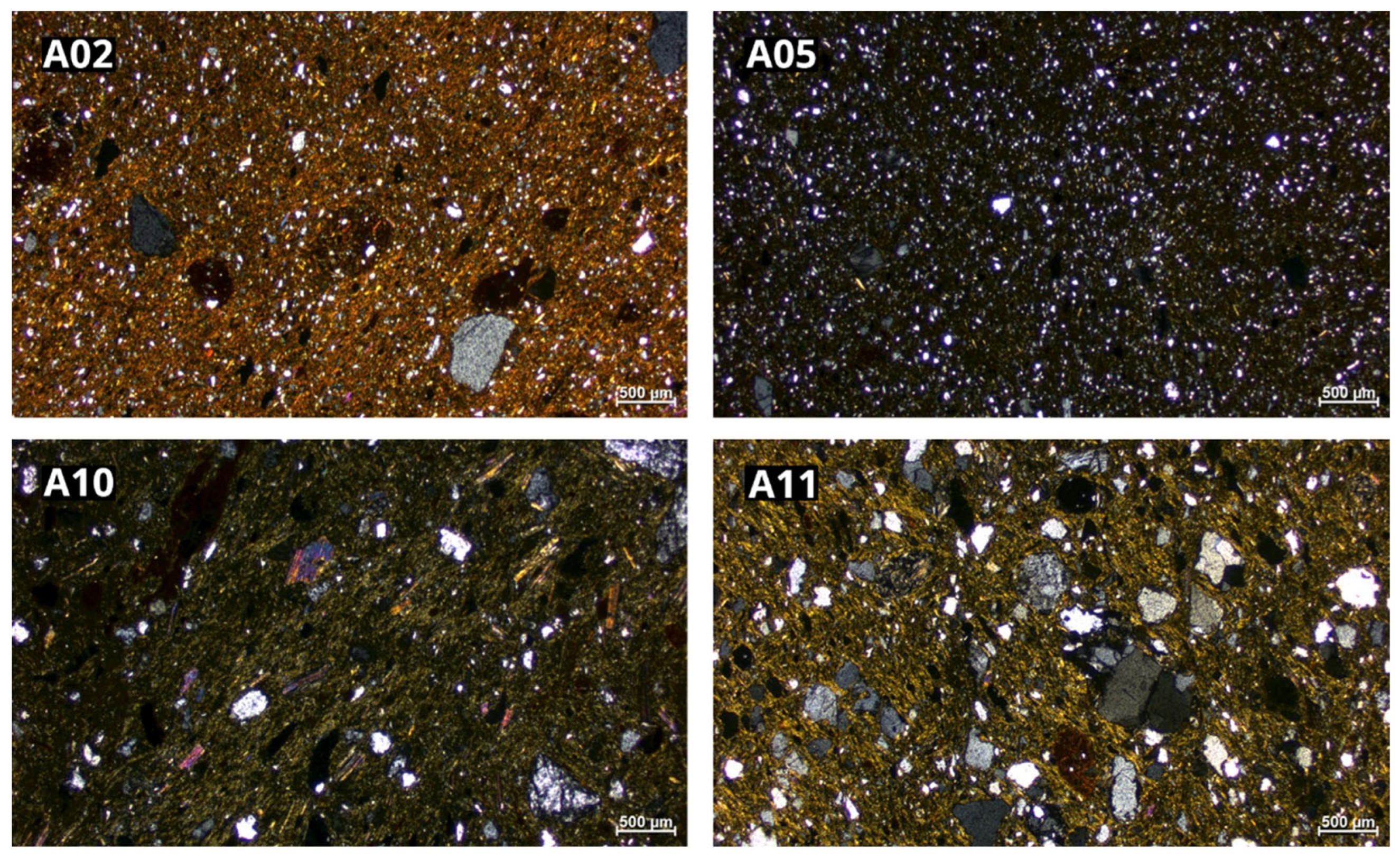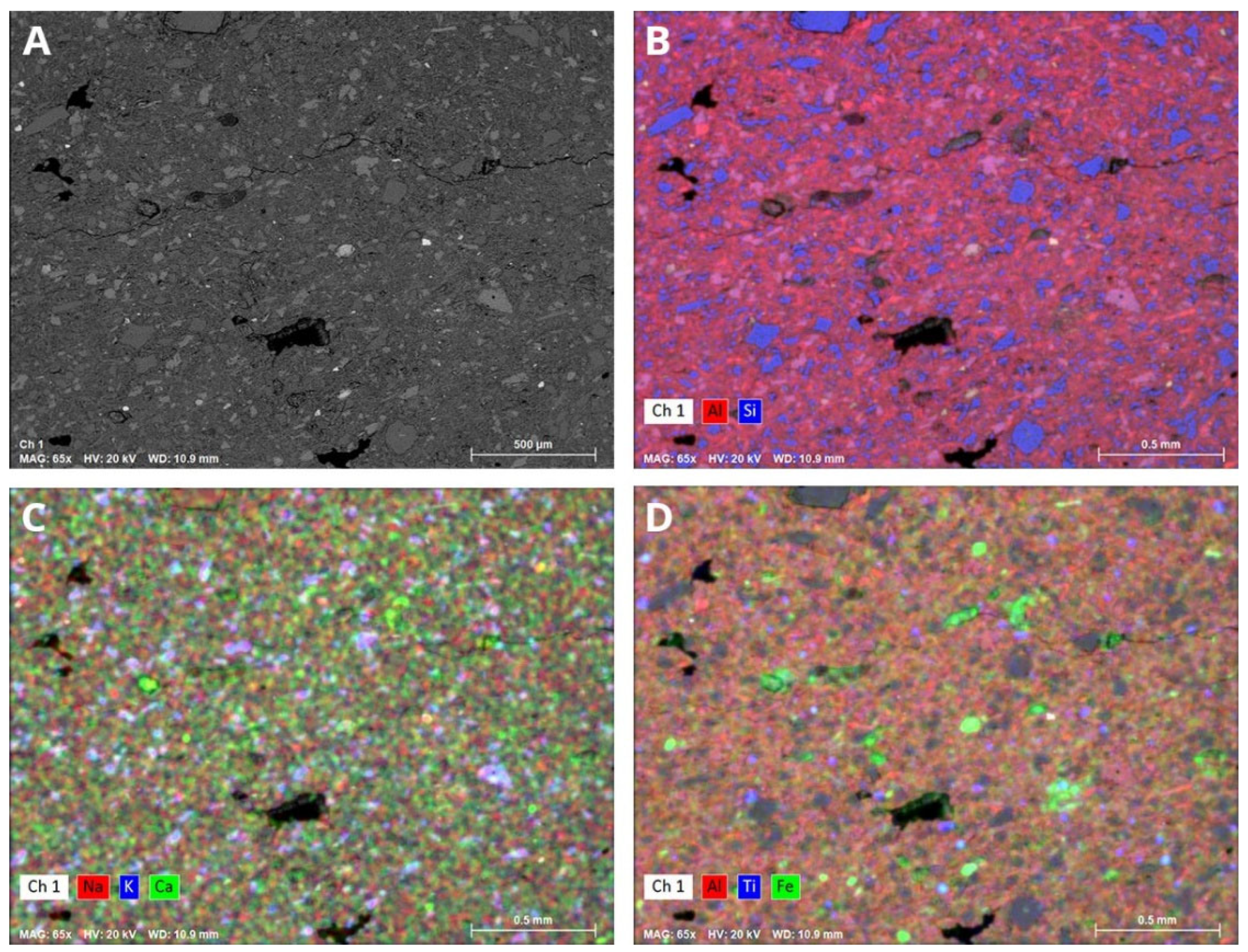Tracing Local Production and Agricultural Trade: A Multi-Analytical Study of Roman Amphorae at Conímbriga (Central Portugal)
Abstract
1. Introduction
2. Materials and Methods
2.1. Materials
2.2. Methods
2.2.1. Optical Microscopy
2.2.2. X-Ray Diffraction
2.2.3. X-Ray Fluorescence
2.2.4. Scanning Electron Microscopy with Energy-Dispersive Spectroscopy
3. Results and Discussion
3.1. Technological Analysis and Raw Material Characterization
3.2. Amphora Functionality and Use: Evidence from Organic and Ceramic Data
4. Conclusions
Author Contributions
Funding
Data Availability Statement
Acknowledgments
Conflicts of Interest
References
- Correia, V.H. Conimbriga: A Vida de Uma Cidade da Lusitânia; Coimbra University Press: Coimbra, Portugal, 2024. [Google Scholar]
- Alarcão, J.; Etienne, R. Fouilles de Conimbriga: Alarcão, J.; et al. Céramiques Diverses et Verres; Diffusion de Boccard: Paris, France, 1976; Volume 6. [Google Scholar]
- Alarcão, P. Construir na Ruína: A Propósito da Cidade Romanizada de Conimbriga; Universidade do Porto: Porto, Portugal, 2009. [Google Scholar]
- Reis, M.P.; Balneis, D.L.V. Estudo Sobre as Termas e Balneários das Cidades da Lusitânia. Ph.D. Thesis, Universidade de Coimbra, Coimbra, Portugal, 2014. Volume 2. [Google Scholar]
- Ruivo, J.; Correia, V.H.; Man, A.D. A cronologia da muralha baixo-imperial de Conímbriga. In Conimbriga Diripitur: Aspetos das Ocupações Tardias de Uma Antiga Cidade Romana; Ruivo, J., Correia, V.H., Eds.; Coimbra University Press: Coimbra, Portugal, 2021; pp. 15–24. [Google Scholar]
- Ruivo, J.; Correia, V.H. Conimbriga Diripitur: Aspetos das Ocupações Tardias de Uma Antiga Cidade Romana; Coimbra University Press: Coimbra, Portugal, 2021; Volume 67. [Google Scholar]
- De Man, A.; Soares, A.M. A datação pelo radiocarbono de contextos pós-romanos de Conimbriga. Rev. Port. Arqueol. 2007, 10, 285–294. [Google Scholar]
- Alarcão, J. Fouilles de Conimbriga V, in La Céramique Commune Locale et Régionale; Diffusion de Boccard: Paris, France, 1975. [Google Scholar]
- Correia, V.H.; Man, A.D. Variação e Constância na Ocupação de Conimbriga e do seu Território; CIDEHUS: Évora, Portugal, 2010. [Google Scholar]
- Correia, V.H.; Buraca, I.; Triães, R.; Oliveira, C. Identificação de uma produção de ânforas romanas no norte da Lusitânia. Rev. Port. Arqueol. 2015, 18, 136–225. [Google Scholar]
- Quinn, P.S. Ceramic Petrography: The Interpretation of Archaeological Pottery & Related Artefacts in Thin Section; Archaeopress Publishing Ltd.: Oxford, UK, 2013. [Google Scholar]
- Wentworth, C.K. A Scale of Grade and Class Terms for Clastic Sediments. J. Geol. 1922, 30, 377–392. [Google Scholar] [CrossRef]
- Riccardi, M.; Messiga, B.; Duminuco, P. An approach to the dynamics of clay firing. Appl. Clay Sci. 1999, 15, 393–409. [Google Scholar] [CrossRef]
- Gliozzo, E. Ceramic technology. How to reconstruct the firing process. Archaeol. Anthropol. Sci. 2020, 12, 260. [Google Scholar] [CrossRef]
- Maritan, L.; Nodari, L.; Milano, A.; Russo, U. Influence of firing conditions on ceramic products: Experimental study on clay rich in organic matter. Appl. Clay Sci. 2006, 31, 1–15. [Google Scholar] [CrossRef]
- Heimann, R.B.; Maggetti, M. The struggle between thermodynamics and kinetics: Phase evolution of ancient and historical ceramics. In The Contribution of Mineralogy to Cultural Heritage; Artioli, G., Oberti, R., Eds.; European Mineral Union and the Mineralogical Society of Great Britain & Ireland: Twickenham, UK, 2019; pp. 233–281. [Google Scholar]
- Xanthopoulou, V.; Iliopoulos, I.; Liritzis, I. Mineralogical and Microstructure Analysis for Characterization and Provenance of Ceramic Artifacts from Late Helladic Kastrouli Settlement, Delphi (Central Greece). Geosciences 2021, 11, 36. [Google Scholar] [CrossRef]
- Oliveira, C.; Buraca, I.; Correia, V.H.; Triães, R. Análises químicas de ânforas identificadas em Conímbriga. Al-Madan 2015, 19, 175–176. [Google Scholar]
- Buraca, S.I.; Olveira, C.J.S.; Elesi, G.; Connan, J.; Morais, R.; Correia, V.H. In Vino veritas. An assessment of current research of amphorae contents from Conimbriga (Portugal). DIAITA Food 2025, 2, e0207. [Google Scholar] [CrossRef] [PubMed]
- Lejay, M.; Alexis, M.A.; Quenea, K.; Anquetil, C.; Bon, F. The organic signature of an experimental meat-cooking fireplace: The identification of nitrogen compounds and their archaeological potential. Org. Geochem. 2019, 138, 103923. [Google Scholar] [CrossRef]
- Lejay, M.; Alexis, M.; Quénéa, K.; Sellami, F.; Bon, F. Organic signatures of fireplaces: Experimental references for archaeological interpretations. Org. Geochem. 2016, 99, 67–77. [Google Scholar] [CrossRef]
- Correia, V.H.; Buraca, I.; Triães, R.; Araújo, A.; Oliveira, C. Identification of a production of Roman amphorae in Northern Lusitania. In Archaeo Analytics—Chromatography and DNA Analysis in Archaeology; Oliveira, C., Morais, R., Cerdán, Á.M., Eds.; Esposende City Council: Esposende, Portugal, 2015; pp. 169–184. [Google Scholar]






| Lab ID | Archaeological ID | Type | Chronology |
|---|---|---|---|
| A01 | 2004_IWT_2 | Conimbriga 1 | 27 BC to 68 AD |
| A02 | 2004_IWT_4 | Dressel 2-4 | 1st century AD (from 69 to 96 AD) |
| A03 | 66_H_VI_44_6 | Dressel 2-4 | 1st century AD (from 69 to 96 AD) |
| A05 | 67_H_VI_43_9 | Dressel 28 | Prior to the 3rd century AD |
| A06 | 66_U_11 | Gauloise 4 | Prior to the end of the 3rd century AD |
| A08 | 66_F_1/67/12 | Gauloise 4 | Prior to the end of the 3rd century AD |
| A09 | 69_H_VIII_47_5 | Conimbriga 2 | 4th century AD to last quarter of 5th century AD (from 305 to 476 AD) |
| A10 | 72_BF6_10 | Conimbriga 45-46 | Last quarter of the 1st century AD to the 3rd century AD |
| A11 | 71_CRY_Norte_Cano | Conimbriga 45-46 | Last quarter of the 1st century AD to the 3rd century AD |
| A12 | 72_BF1_7 | Gauloise 4 | Prior to the end of the 3rd century AD |
| Lab ID | Mineralogy | Rock Fragments | Observations |
|---|---|---|---|
| A01 | Qz, K-Fsp, Pl, Ms | Qtzite | Very abundant in Kfs (microcline) and Ms |
| A02 | Qz, K-Fsp, Pl, Ms | Not homogenized Clp identified | |
| A03 | Qz, K-Fsp, Pl, Ms | Not homogenized Clp identified | |
| A05 | Qz, K-Fsp, Pl, Am, Ms | Rare Am. Not homogenized Clp identified | |
| A06 | Qz, K-Fsp, Pl, Ms | ||
| A08 | Qz, K-Fsp, Pl, Ms | Not homogenized Clp identified | |
| A09 | Qz, K-Fsp, Pl, Ms, Bt (very rare) | Qtzite | Ms-rich |
| A10 | Qz, K-Fsp, Pl, Ms, Bt (very rare) | Qtzite, Clst, Gnrd | Ms-rich |
| A11 | Qz, K-Fsp, Pl, Ms, Bt, Grt | Qtzite, Clst, Gnrd | Ms- and Bt-rich |
| A12 | Qz, K-Fsp, Pl, Ms | Not homogenized Clp identified |
| Lab Id | Ceramic Paste | Porosity | |||
|---|---|---|---|---|---|
| Color | Hom./Het. | Enrichment in Fe or Ca | Optical Activity | Shape and Size | |
| A01 | Brown | H.HOM. | Fe | S | Vesicles (meso) |
| A02 | Red | H.HOM. | Fe | S | Vesicles (meso) |
| A03 | Red | H.HOM. | Fe | S | Vesicles—Chanels (macro, mega) |
| A05 | Red | H.HOM. | Fe | S | Vesicles—Chanels (meso, macro) |
| A06 | Red | H.HOM. | Fe | S | Vesicles (micro, macro) |
| A08 | Red | H.HOM. | Fe | S | Vesicles (micro, meso) |
| A09 | Brown | M.HOM. | Fe | S | Vesicles—Planar voids (meso, macro) |
| A10 | Brown | M.HOM. | Fe | M | Vesicles—Chanels (meso, macro) |
| A11 | Brown | M.HOM. | Fe | M | Vesicles—Chanels (meso, macro) |
| A12 | Red | H.HOM. | Fe | NA | Vesicles (micro, meso) |
| LAB ID | Temper | |||||||
|---|---|---|---|---|---|---|---|---|
| Shape | Sphericity | Packing | Alignment | Sorting | GSD | DGSF | Temper % | |
| A01 | G | A-R | CS | P | M | U | VFS/FS | 20 |
| A02 | G | A-R | CS | F | W | U | CSilt | 10 |
| A03 | G | SR-R | CS | F | W | U | CSilt–VFS | 20 |
| A05 | G | SR-R | CS | F | W | U | CSilt | 20 |
| A06 | G | SA-R | CS | F | W | U | CSilt | 10 |
| A08 | G | SR-R | CS | F | W | B | CSilt/CSand | 10 |
| A09 | G/El | A-SR | CS | P | P | B | CSilt/CSand | 10 |
| A10 | G/El | VA-SA | OS | P | P | U | FS | 10 |
| A11 | G | A-SR | SS | M | M | B | VFS/CSand | 10 |
| A12 | G | SA-R | CS | F | W | U | CSilt | 20 |
| Lab ID | Qz | Kfs | Pl | Hm | Cal | I/M | Bt | Mul |
|---|---|---|---|---|---|---|---|---|
| A01 | xxxx | xx | x | xx | ||||
| A02 | xxxx | x | xx | x | vs | x | ||
| A03 | xxxx | vs | vs | x | vs | |||
| A05 | xxxx | xx | vs | x | x | |||
| A06 | xxxx | xx | vs | x | vs | xx | ||
| A08 | xxxx | xx | vs | x | x | |||
| A09 | xxxx | xx | vs | vs | x | |||
| A10 | xxxx | x | vs | x | xxx | |||
| A11 | xxxx | xx | x | x | x | xxx | ||
| A12 | xxxx | xx | x | x |
Disclaimer/Publisher’s Note: The statements, opinions and data contained in all publications are solely those of the individual author(s) and contributor(s) and not of MDPI and/or the editor(s). MDPI and/or the editor(s) disclaim responsibility for any injury to people or property resulting from any ideas, methods, instructions or products referred to in the content. |
© 2025 by the authors. Licensee MDPI, Basel, Switzerland. This article is an open access article distributed under the terms and conditions of the Creative Commons Attribution (CC BY) license (https://creativecommons.org/licenses/by/4.0/).
Share and Cite
Buraca, I.; Oliveira, C.; Bottaini, C.; Correia, V.H.; Schiavon, N.; Mirão, J.; Beltrame, M. Tracing Local Production and Agricultural Trade: A Multi-Analytical Study of Roman Amphorae at Conímbriga (Central Portugal). Heritage 2025, 8, 405. https://doi.org/10.3390/heritage8100405
Buraca I, Oliveira C, Bottaini C, Correia VH, Schiavon N, Mirão J, Beltrame M. Tracing Local Production and Agricultural Trade: A Multi-Analytical Study of Roman Amphorae at Conímbriga (Central Portugal). Heritage. 2025; 8(10):405. https://doi.org/10.3390/heritage8100405
Chicago/Turabian StyleBuraca, Ida, César Oliveira, Carlo Bottaini, Vírgilio Hipólito Correia, Nicola Schiavon, José Mirão, and Massimo Beltrame. 2025. "Tracing Local Production and Agricultural Trade: A Multi-Analytical Study of Roman Amphorae at Conímbriga (Central Portugal)" Heritage 8, no. 10: 405. https://doi.org/10.3390/heritage8100405
APA StyleBuraca, I., Oliveira, C., Bottaini, C., Correia, V. H., Schiavon, N., Mirão, J., & Beltrame, M. (2025). Tracing Local Production and Agricultural Trade: A Multi-Analytical Study of Roman Amphorae at Conímbriga (Central Portugal). Heritage, 8(10), 405. https://doi.org/10.3390/heritage8100405







